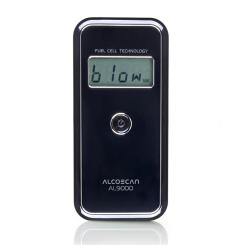- Home
- Products
- Knowledge Base
- Sales
- Customer Support
- Contact Us
- Order Desk: 866-216-8700
Welcome to ASD! Call us at 866-216-8700 to place your order today.
 |
How Does a Breathalyzer Work? |
|
Tuesday 10 March, 2015.
|

A breathalyzer is a device used to provide an estimation of how intoxicated an individual is by analyzing a sample of their breath. These devices are most known for their use by police officers to determine if they have pulled over a driver who has been drinking too much to safely operate their vehicle. In addition to drunk driving enforcement, breathalyzers are used in substance abuse facilities and even certain workplaces, usually where safety is an issue. But what does a person's breath have to do with how much they have been drinking - and exactly how does a breathalyzer work? Depending on the type of breathalyzer, there are several answers to those questions. There are actually three four types of breathalyzer devices, the names of which are based on their method of function.
Semiconductor
Chemical
Infrared
Fuel Cell
All three types of alcohol tester require a person to blow a breath sample through a mouthpiece and tube into a sample chamber The disposable breathalyzer device uses a glass vial containing a mixture of chemicals that will elicit a chemical response when alcohol is introduced. The mixture is calibrated to only respond to a predetermined BAC. When the threshold is met, a color change occurs resulting in a positive test The Infrared type of alcohol tester uses infrared spectroscopy to identify alcohol molecules by the way they absorb infrared light. Molecules are always in a state of vibration, and when infrared light is introduced it can change the way a molecule is vibrating. Chemical bonds will be stretched and bent when infrared light is absorbed. Because each type of bond will absorb infrared light at a different wavelength, these devices algebraically determine what molecules are present based on the wavelength of infrared molecule absorbed by any given molecule. The last type of alcohol breath test is the fuel cell breathalyzer. A fuel cell is a device designed to force a reaction with oxygen or another oxidizing agent to convert chemical energy into electricity. Fuel cell breathalyzers send the breath sample through a chamber with the fuel cell, which uses platinum to oxidize any alcohol in the air to produce acetic acid, protons and electrons. Using an electrode made of platinum, the electrons flow through an electrical current meter to the other side of the fuel cell. The protons move through the bottom of the fuel cell and, once combined with the electrons and oxygen to create water. The more alcohol that is present in the breath sample, the more electrical current is produced. A small microprocessor analyzes the current generated and uses this figure to determine an estimated BAC. So, How Do Breathalyzers Actually Work?All of these types of breath alcohol testers have one thing in common: they rely on a sample of a person's breath to determine BAC. BAC, however, stands for Blood Alcohol Content - not Breath Alcohol Content - so how are breathalyzers able to determine how much alcohol is in someone's blood stream simply based on how much alcohol is in their breath? The answer to this question is actually pretty simple. In 1803, English chemist William Henry developed what is now referred to as Henry's law. It states: "At a constant temperature, the amount of a given gas that dissolves in a given type and volume of liquid is directly proportional to the partial pressure of that gas in equilibrium with that liquid". How Henry's law relates to breathalyzers is a bit more complicated, but here's a basic explanation. Since alcohol is a volatile compound that dissolves in diffuses in water, it should follow these same laws established by Henry over two centuries ago. Additionally, the temperature of a human being is relatively constant at an average of 98.6 degrees Fahrenheit. Human breath leaves the mouth at a slightly cooler temperature of 93.2 degrees Fahrenheit on average. Since all of these variables are somewhat predictable, scientists were able to determine that the best ratio to use is 2100:1 to use alcohol measured in the breath to estimate alcohol present in the bloodstream. This value is underestimated to account for the standard deviations that would occur in such a test, for example, any given persons particular body temperature at any given time will likely vary by a degree or two. Using this ratio, a breathalyzer device is able to successfully approximate, quite accurately, the BAC of a person just from a breath sample. Although these devices can be extremely reliable and accurate, there are still some flaws present which DUI defense lawyers in particular attempt to exploit. A breathalyzer must be used by a trained professional and depending on the unit proper calibration is absolutely essential for the breathalyzer to work. If calibration sounds like a huge inconvenience to you, consider a model like the AlcoMate Premium, a breathalyzer that uses an advanced semiconductor and never needs recalibrating. |